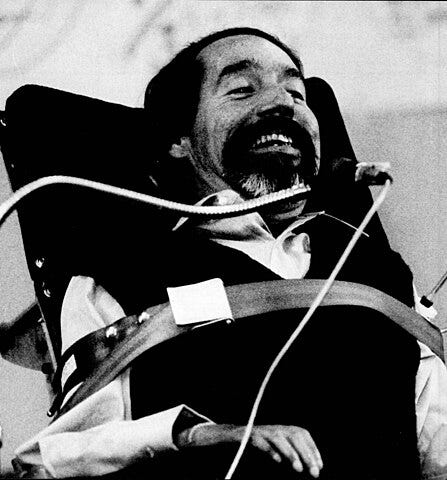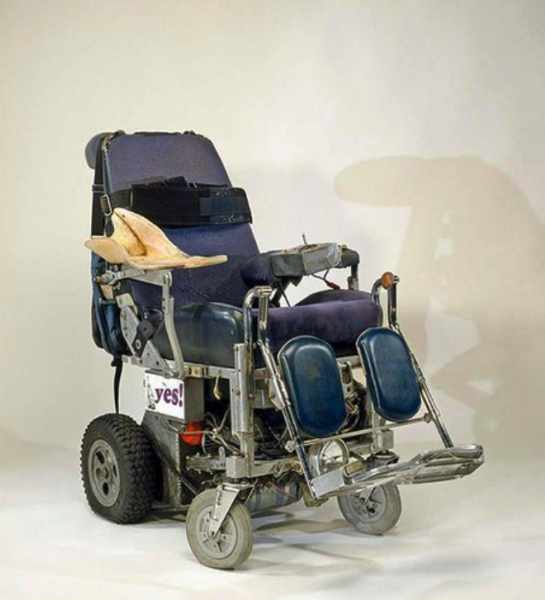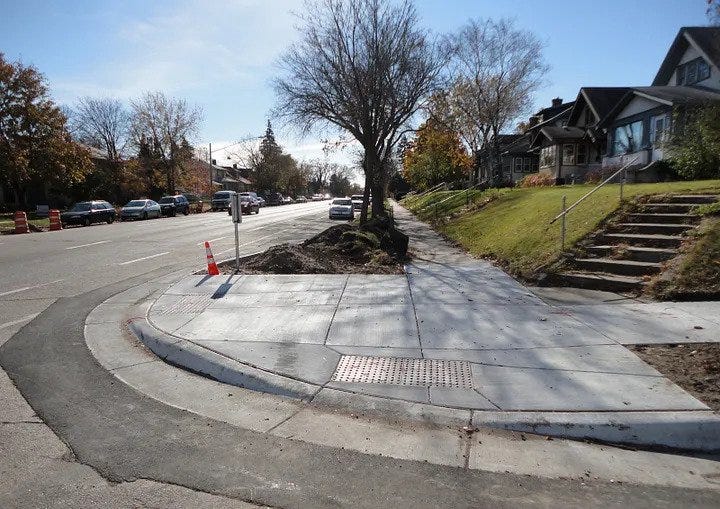
When it comes to disability rights and advocacy, few names have such a lasting impact as that of Ed Roberts.
Widely hailed as the father of the independent living movement, Roberts’ life and work stand as a towering testament to the power of resilience and determination. A lifelong fight against so called ‘insurmountable challenges’ realised as a relentless pursuit of equality, not only altered his life and other disabled people around him -
It also forged a path for countless others in the disability community.
Born in 1939, Roberts’ world was irrevocably changed at the age of 14 when he contracted polio. The disease left him paralyzed from the neck down, using an iron lung for breathing. Refusing to accept the societal constraints placed upon individuals with disabilities, he embarked on a path that would challenge and eventually change the prevailing narratives around disability.
Roberts’ legacy is intricately tied to the movement that championed the rights and independence of people with disabilities. His advocacy was not just a personal crusade but a broader fight for accessibility, inclusion, and respect. His efforts were pivotal in reshaping public policies, perception and attitudes.
His story is one of triumph over adversity, a narrative that continues to inspire (in the truest sense) and drive forward the ongoing struggle for disability rights. Ed Roberts was not just a champion of accessibility; he was the first modern catalyst for change, whose influence reverberates to this day in every ramp, every accessible building, and every life touched by the independent living movement.
Ed Roberts’ journey into the realm of disability rights activism began not through choice, but necessity. At the age of 14, Roberts faced a life-altering challenge when he contracted polio, which left him paralyzed and dependent on an iron lung. Polio had left many adults and children disabled at the time, before vaccines were introduced in the 50s and 60s, but these individuals were relegated to the side-line of society. For Ed Roberts this marked the beginning of a series of struggles and triumphs that would shape not only his future but also the landscape of disability rights in the United States.
Roberts’ educational journey was marked by significant obstacles from the outset. His high school initially refused to grant him a diploma because he had not completed the required physical education. Requirements he, obviously, could not fulfil due to his paralysis. Undeterred, Roberts and his family challenged this decision, advocating for his right to graduate. Their perseverance paid off, and Roberts emerged victorious, receiving his high school diploma. Not just a significant milestone in his early fight for equal rights but proof that it could be achieved.
This early fight, and victory, may have led to him years later stating:
“I’ve always figured it took no more energy to dream big dreams as little ones”

This triumph, precured by a fight, become a repeating pattern to Roberts. His ground-breaking enrolment at the University of California, Berkeley in 1962, began with the dean stating “We’ve tried cripples before and it didn’t work.”.
Regardless, through persistence UC eventually caved and he became the first severely disabled student to attend the university. His time at Berkeley was both challenging and transformative. The university was not equipped to accommodate a student with his level of disability; dormitories could not support the weight of his 800-pound iron lung, compelling Roberts to reside in an empty wing of the campus hospital. This unconventional arrangement, however, did not deter him. Instead, it fuelled his determination to create a more inclusive environment for people with disabilities.
Roberts didn’t just set a precedence for future generations. He actively founded the Physically Disabled Students Program at UC Berkeley, the first initiative of its kind in the United States. This program, borne out of necessity, aimed to provide support and resources to students with disabilities, ensuring their right to education and accessibility on campus.
Not stopping there he further fostered a community of students with disabilities — The Rolling Quads. This group was instrumental in pushing for greater campus accessibility at UC Berkeley, challenging the status quo and paving the way for significant infrastructural and policy changes. The Rolling Quads in their retrofitted campus hospital student dormitory became the beginning of the Independent Living Movement.
Roberts’ quest for independence saw him innovate in ways that would later benefit many in the disabled community. One notable example was his modification of a power wheelchair. Initially told he would never be able to drive a power wheelchair due to limited mobility in his fingers, Roberts of course challenged this notion. He ingeniously adapted the control mechanism of the wheelchair, allowing him to operate it and gain greater independence. This adaptation was more than a personal victory; it was a reinforcement of the philosophy that disabilities should not define one’s ability to lead an independent and fulfilling life. Today one of the most intelligent minds in the world, Stephen Hawking, relies on similar technology.

We also saw independence given to many others around him. Roberts often found his social moments and, ahem, more intimate moments with others difficult to enjoy with the constant presence of a human medical aid. With his new chair he was able to manoeuvre around small sections of the university independently. But it was impossible to cross many streets as, like today, a raise of almost a foot met Roberts on each side. This wasn’t just a matter of inconvenience, it was dehumanising and another reminder of the consistent barriers disabled people face even after gaining access to a system. Angered by this, Roberts and The Rolling Quads took advocacy further than before. Sometimes systemic change is physical so they took to the campus streets with sledgehammers and created the systems they needed — in the form of curb cuts.

Curb cuts are the most symbolic example of universal design in the built environment. Little ramps in the curb that provide access for wheelchair users, cyclists, prams, delivery carts, shopping carts, scooters, skateboards….
His experiences during these formative years laid the foundation for his future as a pioneering advocate for disability rights and independence.
Nationally, perhaps the most enduring symbol of Roberts’ legacy is the establishment of the first Center for Independent Living (CIL) in Berkeley in 1972. This center emerged as a revolutionary model, advocating for and supporting the independent living of people with disabilities. The CIL provided a range of services, from peer counselling to advocacy, and became a template for similar centers across the nation. Its establishment marked a significant shift in the way disability was perceived and addressed, moving away from a medical model to a social model and with it one of empowerment and self-determination.
Just a year later Roberts was also a prominent figure in the wider disability rights movement. His involvement in the 504 sit-ins, whilst not done alone, was a pivotal event in the history of disability rights activism,. The sit-ins were a demonstration against the delay in implementing Section 504 of the Rehabilitation Act of 1973, which was the first federal civil rights protection for people with disabilities.
Globally, Ed Roberts’ legacy lives on through various initiatives and institutions that he helped establish and inspire. Among these is the World Institute on Disability (WID), which he co-founded. WID continues to be a leading global voice in disability rights, conducting research, policy analysis, and advocacy.

Whilst Ed Roberts’ passed away in 1995 Roberts’ influence is and will forever be evident in the increased accessibility of public spaces, from wheelchair ramps and accessible public transportation to the widespread implementation of ADA standards in buildings and facilities. His influence has and will continue to also spread through advocates and people with disability as a reminder Independent Living is possible.
His vision and advocacy have played a pivotal role in the social model of disability we see today, a social model where barriers to participation for people with disabilities are continually being dismantled.
Here’s to Ed Roberts, Accessibility Champion.
“Independent Living does not mean that we want to do everything by ourselves, do not need anybody or like to live in isolation. Independent Living means that we demand the same choices and control in our every-day lives that our non-disabled brothers and sisters, neighbors and friends take for granted. We want to grow up in our families, go to the neighborhood school, use the same bus as our neighbors, work in jobs that are in line with our education and interests, and raise families of our own. We are profoundly ordinary people sharing the same need to feel included, recognized and loved.” — Philosophy of Independent Living